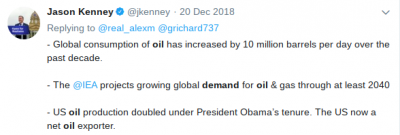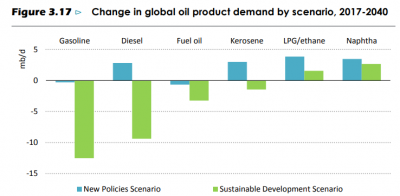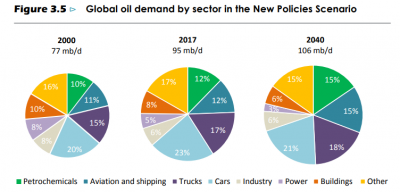
Kenney, CAPP misuse IEA oil demand scenarios in public comments. They should stop doing that.
The common view amongst Alberta politicians and industry leaders is that the world will need oil for many decades yet – so why be in a rush to change? – and they point to “forecasts” from the International Energy Agency (IEA) to bolster their case. The truth is, the IEA only forecasts out five years. Ater that, it’s scenario modeling of many possible futures, several of which paint a less than rosy picture for Alberta.
 For example, take this comment from a June 13 media release from the Canadian Association of Petroleum Producers (CAPP): “By 2040, global oil demand is anticipated to increase 12 per cent, to 106.3 million b/d. ”
For example, take this comment from a June 13 media release from the Canadian Association of Petroleum Producers (CAPP): “By 2040, global oil demand is anticipated to increase 12 per cent, to 106.3 million b/d. ”
Intentionally or not, the statement is misleading. CAPP is referring to the mid-range oil demand scenario in the IEA’s World Energy Outlook 2018. The high-range is 120 million barrels per day, but the low-range is just 70 million barrels per day. The IEA also generates scenarios about more specific issues that affect oil consumption, like providing universal energy access across the world or the health consequences of energy-related air pollution.
Frankly, CAPP is cherrypicking the data, but industry isn’t alone. Premier Jason Kenney frequently quotes the same IEA “forecast,” as do other industry and business leaders.

To clarify how the IEA oil consumption scenarios are created and how they should be used, Energi Media interviewed Tim Gould, head of supply division for the World Energy Outlook based in Paris. The interview has been lightly edited for clarity.
Markham: Are Alberta political and industry leaders correctly using IEA oil demand scenarios?
Gould: The IEA doesn’t have a long-term forecast. We differentiate between the near-term horizon, those stretch out typically for five years, but once you start looking beyond that, you move into scenario territory. What happens under certain circumstances? What are the levers that need to be moved to create different outcomes for the global energy system? What decision-makers need to understand is the direction of travel.
Markham: How are greenhouse gas emissions and oil demand treated under the various scenarios?
Gould: There are significant environmental consequences to that type of trajectory. The clearest example, of course, is the volume of emissions. Our New Policies Scenario does not see an early peak in emissions that would be necessary to meet the Paris agreement. Instead, we foresee a steady rise in energy energy-related CO2 emissions between now and 2040. In this scenario, we set the stands and conditions, then let the model come to its conclusions.

But you can’t assess the adequacy of that scenario unless you have another view on what might be necessary in order to achieve other policymakers’ goals. We have a Sustainable Development Scenario, which is a different kind of beast. In this case, you set the desired endpoint, which is consistent with a trajectory of well below two degrees warming of the Paris agreement, then you work backward to see what is needed to reach that goal. This scenario also incorporates other goals, such as a big reduction in the pollutants that cause poor air quality.
We discourage people from referring to these scenarios as forecasts, partly because they don’t allow for the evolution of policy. It may be that a government elected next year or the year after does something very different from what the current government. We don’t second guess those reactions, what might be in the next round of climate negotiations. That’s one of the key reasons why it would be misleading to assume that the New Policy Scenario, in particular, is a forecast.
Markham: How should policymakers approach your scenarios?
Gould: They should approach them as a way to understand the implications, the limitations, and the cumulative impacts of the decisions that they are taking at the moment. To consider the implications of the direction of travel indicated by their policies. That is not just an affirmation of where we’ll end up. It’s also a warning of the possible consequences of going in that direction.
This is where you’re heading, are you happy with that? And, if you’re not happy, then you can change it by doing things differently today.
Markham: Imagine you’re Alberta Premier Jason Kenney. The Alberta oil sands are the biggest producer of heavy crude oil in the world. Producers are lowering their emissions and decarbonizing that heavy crude, anticipating an expansion of Asian markets over the next 20 years. How might you use the IEA scenarios as a planning tool?
Gould: I think you’d look at a few things. One, you’d compare the outlooks for the industry in the New Policy scenario and in the Sustainable Development scenario, as well as other scenarios that you think are credible. You’d want to examine future opportunities and future risks.

Two, you’d look at the projections for oil demand based on what we know today and the volumes of investment that would be required to meet demand in different scenarios. We did some analysis a couple of years ago suggesting that more than 80% of the investment in oil and gas is just to maintain today’s production; only around 20% is about meeting that increase in demand. The decline rates from existing oil fields are much greater than the growth of future demand. There will need to be continued investment in the upstream even in a fairly ambitious deep decarbonization scenario. That’s not widely appreciated outside the industry.
Markham: What weight should Alberta put on the potential for technology disruption? I’m thinking primarily of electrification of transportation, autonomous driving and Mobility as a Service, the kinds of disruptions that affect oil demand in a short time?
Gould: There’s are some scenarios we’ve done that try to answer that question. We did a deep dive we called the “future is electric” scenario where we tried to estimate the implications of pushing electrification of as hard as we reasonably could. We rapidly electrified transportation, heat for buildings and, and to a degree low-temperature heat for industry.

That is enough to generate a peak in global oil demand by the late 2020s.
It’s important to bear in mind that passenger vehicles are around a quarter of global oil demand. If you want to have a really disruptive influence on the future of oil you need to look beyond individual mobility and think through what happens to freight trucks and shipping, aviation, and what happens to other areas like petrochemical feedstocks.
Markham: Any final thoughts?
Gould: Our goal with this work is not to tell people where we’re going to be in 20 or 40 years. It’s to provide a framework for people to think about available choices and the implications of those choices. For instance, a discussion you hear a lot of in Alberta is the emissions associated with getting that oil out of the ground, refining it and getting it to market.
I’d encourage you to look at work that we did in our 2018 Outlook where we for the first time put together a detailed emissions-intensity curve for today’s oil production. In our view, customers, regulators, and governments are going to be paying more attention in the future to how that crude oil has been produced and transported and so on. It is something that the Canadian authorities are very aware of.
Interview takeaways
Premier Kenney and CAPP are cheerleaders for the Alberta oil industry. Full stop. So, we shouldn’t be surprised that they traffic in simple narratives designed to make Albertans feel good about the future of the industry.
The oil sands companies, on the other hand, are deeply invested in scenario modeling. They understand the global energy system is transforming, presenting both risks and opportunities, and they fully intend to be as prepared as possible.
Why? Consider this observation from a recent insight from the Oxford Energy Institute: “…there is a difference between the timescale within which the [energy] transition is completed and the timescale within which the manifestation of its effects on energy markets are felt’.
In other words, long before peak oil demand, long before humans have stopped combusting oil for transportation, the energy transition will have significant impacts on the Canadian oil and gas sector, especially in Alberta.
Therefore, Albertans need to ask themselves this question: do they want their leaders to spout the feel-good pablum – based upon misleading interpretations of IEA scenarios – of Premier Kenney and CAPP or the more realistic approach of the companies that produce 80% of Alberta’s crude oil supply?
Thus far, Kenney and CAPP dominate the public discussion about the future of oil. Perhaps that needs to change.


Be the first to comment